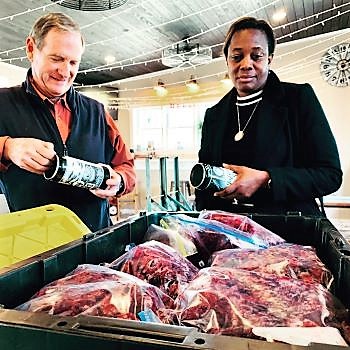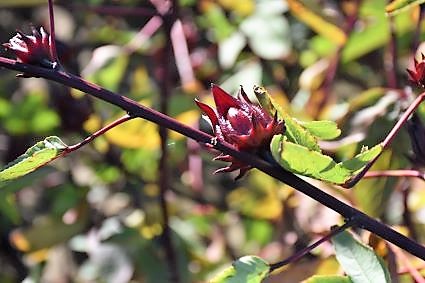
UMES researcher focuses on making it a cash crop
Tuesday, February 11, 2020
Most people recognize hibiscus as a tropical plant with beautiful bright blossoms, but little do they know of its importance as a crop. Dr. Nadine Burton, an alternative crop specialist, is researching the plant’s viability for local farmers at UMES’ Education and Demonstration Farm.
Hibiscus, or Hibiscus sabdariffa as it is known scientifically, belongs to the Malvaceae family. There are over 300 species of annual or perennial herbs to the genus. Hibiscus is rich in nutritive value and has been shown to possess phytochemical and pharmacological properties.
It is high in vitamin C and flavonoids, and “… right up there with aronia and pomegranate with antioxidants,” Burton said. The calyx, or sepals of the flower that form a whorl that encloses the petals and forms a protective layer around a flower in bud, are used to make tea, juice, jams and jellies.
Burton, who earned her Ph.D. in food science and technology from UMES in 2017, said hibiscus can also be used in cosmetics such as shampoo and soap. In some countries, the leaves are an ingredient in stews and the stems have been used in making fishing nets.
Some 350 pounds of hibiscus seeds have been harvested from 170 plants on UMES’ research farm on Stewart Neck Road, Burton said. Planted in June and harvested this past September and October, this is the first time in three years the current variety has grown well, she said.
The plants require 13 hours of sunlight before the calyx forms.
The Mid-Atlantic “adopted” variety, as it is being renamed, is a “high value-added property.” One quart of drink can be made from ½ lb. of fresh calyx and can produce three 12-ounce bottles, which can carry a market value of $7, Burton said.

UMES research is not profit-driven but instead is geared to introduce findings to local farmers and the agriculture community. Four major clients currently use UMES’ processed hibiscus: Black Narrows Brewery in Chincoteague, Va. for its beer; Shore Gourmet Development in Denton, Md. for its kombucha tea; Habanera Farms, LLC in Tyaskin, Md. for its herbal teas; and for research by Corrie Cotton, an assistant research professor at UMES.
Farmers who are interested also are given the seeds and seedlings to experiment with. Burton shows them different techniques to maximize their growing space to maximize yield.
Harvesting is labor intensive. Calyxes are plucked from the plants. Seeds are hand removed with an apple corer and washed with a special solution. They’re then spread to dry and finally freeze-dried in a USDA-approved system. Studies have shown no nutrients are lost in freezing, Burton said.
The UMES Education and Demonstration Farm is “gearing up to be a kitchen to help farmers process and package hibiscus.” Currently, farmers’ products are not in a condition for long shelf life. Processed and packaged correctly, however, seeds can be kept for three to four years.
By Gail Stephens

